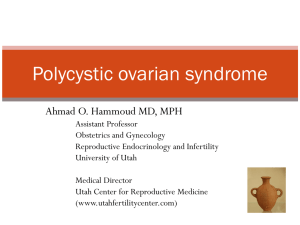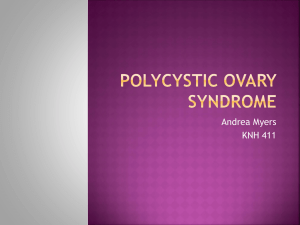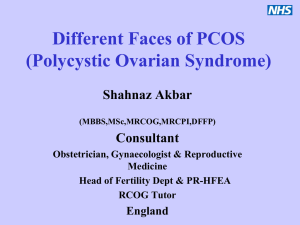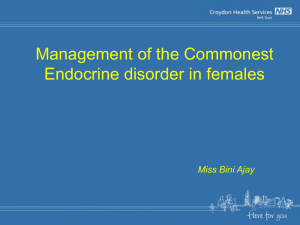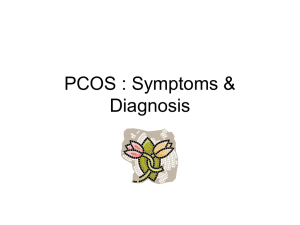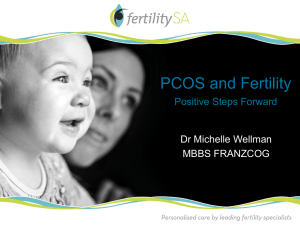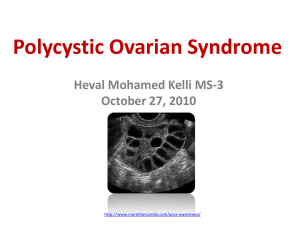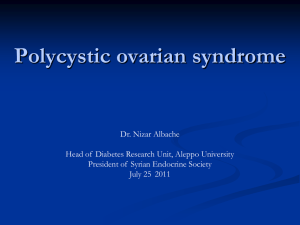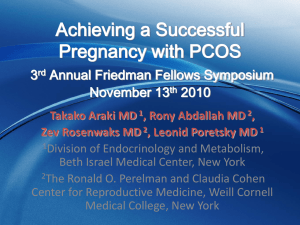PCOS in Gynac View & Mirena - Nagercoil Obstetric and
advertisement
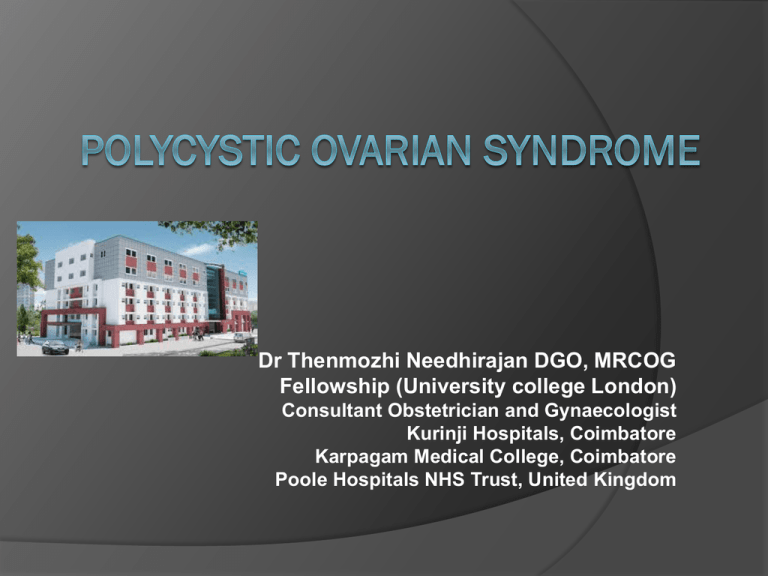
Dr Thenmozhi Needhirajan DGO, MRCOG Fellowship (University college London) Consultant Obstetrician and Gynaecologist Kurinji Hospitals, Coimbatore Karpagam Medical College, Coimbatore Poole Hospitals NHS Trust, United Kingdom My work in India CEMENDS (Centre for Menstrual disorders & Gynae Endoscopy) – Ambulatory Gynaecology Lifetime screening programme for cervical cancer Computerised recall system, Periodical smears, Colposcopy Vulvoscopy for vulval leisions Cervical cancer Vaccination Cryotherapy CEMENDS – Ambulatory Gynaecology Non – Hysterectomy Options for Menstrual disorders Office Hysteroscopy for menstrual disorders Medical management of fibroid LNG-IUS Transcervical Resection of Endometrium (TCRE) Transcervical Resection of Fibroid/ polyp (TCRF) NOVASURE Endometrial Ablation Hysteroscopic Uterine Septoplasty for uterine septum Menopause and Hormone Replacement Therapy History and Epidemiology 1st described by Irving Stein and Michael Leventhal as a triad of amenorrhea, obesity and hirsutism (1935) The most common endocrine disorder in women of reproductive age ~ 2%-8% of women Knochenhauer ES et al, Journal of Clinical Endocrinology & Metabolism, 1998. Current suggested prevalence Caucasian: 4.8% African American: 8.0% Hispanic or Latino: 13% 5%-10% of women Azziz R et al, Journal of Clinical Endocrinology & Metabolism, 2004. Goodarzi MO et al, Fertility and Sterility, 2005. Ehrmann DA, New England Journal of Medicine, 2005. What is PCOS? A chronic condition characterized by anovulatory infertility, hyperandrogenism , hyperinsulinaemia, insulin resistance with clinical manifestations of oligomenorrhoea,hirsutism and acne Definition 1990 NIH DEFINITION 1. OLIGOMENORRHEA 2. HYPERANDROGENEMIA 3. Absence of other disorders such as NCAH, Hyperprolactinemia, thyroid dysfunction. Rotterdam Criteria (2003) Two of the three: – Menstrual irregularity due to anovulation or oligo-ovulation – Clinical signs (Acne, Balding, Hirsuitism) or biochemical hyperandrogenism – Polycystic ovaries on ultrasound Pathogenesis OVARIAN HYPOTHESIS: – Thecal ( ovarian interstitial tissue) hypertrophy, leading to hyperandrogenemia – excessive activity of an enzyme called 17,20 lyase CENTRAL HYPOTHESIS: abnormal GnRH pulse generation from the hypothalamus leading to abnormal, increased LH pulse amplitude and frequency Clinical Features Remember it is a syndrome, not a disease! It’s the most common disorder of the Endocrine system in women, 5-10% Frequently begins around time of puberty Strong genetic component, frequently a family history of type 2 DM Consensus Workshop 3rd PCOS consensus workshop- Netherlands Oct 2010 • Adolescence • Hirsutism & Acne • Contraception • Menstrual cycle abnormalities • Quality of life and sexual health • Pregnancy complications • Cardiovascular & cancer risk PCOS in Adolescence • No overall agreement on diagnosis • Acne is common in adolescence • Hirsutism typically develop over years • Irregular periods also common • Hyperandrogenaemia –consistent marker • 85% of the menstrual cycles are anovulatory in the first year • Increased BMI –major risk factor for persistent anovulation • Only 40% of adolescents with irregular periods have polycystic ovaries on USS Diagnosis in Adolescence • All 3 elements of Rotterdam criteria should be present Conclusions • Diagnostic criteria should differ from from those used for older women of reproductive age • Groups at risk (obese, hirsute, irregular periods))should be identified but be cautious of over diagnosing • Individual manifestations should be treated Adolescent PCOS –Lack of knowledge Absence of longitudinal studies Absence of specific diagnostic criteria Absence of normative values for a number of biochemical markers Value of intervention Unclear if the severity of the symptoms predicts the extent of the disorder in later life Hirsutism/Acne/Alopecia • Hirsutism-Good marker for hyperandrogenism Present in 70% of women with PCOS • Hyperandrogenaemia should be evaluated biochemically in all women • Acne and Alopecia not commonly associated with hyperandrogenaemia • If Hirsutism major concern – reduction in androgen production decrease the circulating free testosterone limit androgen bioactivity to hair follicles terminal hair turnover occurs slowly- atleast 6 months treatment is essential Treatment of Hirsutism/Acne/Alopecia • • • • • • • • Focused on Inhibition of ovarian steroid production Decreased bioavailability – Increase SHBG levels (OCPs) OCPs often combined with antiandrogens to block androgen action at hairfollicles Antiandrogens – Cyproterone, Spirinolactone, flutamide, finasteride drospirenone Antiandrogens should not be used without contraception Metformin has little effect on hirsutism and acne Physical approaches to remove hair- electrolysis,laser Severe Acne-Isoretinoin is beneficial Topical use of Eflornithine hydrochloride- hirsutism No effective pharmacological treatment for alopecia Hirsutism/Alopecia/Acne Lack of evidence Unclear Best medical therapy for hirsutism Unclear how long therapy should be continued Unclear how best to evaluate hirsutism clinically Measurement of serum androgens is fraught with error Menstrual Irregularity • Women with PCOS may ovulate spontaneousely • How frequent- unknown • Oligo/amenorrhoea-90% chance of being diagnosed with PCOS • Amenorrheic women- most severe hyperandrogenism/higher antral follicle counts • Menstrual cycles become more regular towards menopause • Irregular periods are associated with increased metabolic risk • The greater the irregularity the more severe the PCOS phenotype Treatment of Menstrual Irregularities Weight Loss Oral Contraceptives Provera – 5-10mg for ten days every 4-8 weeks Treatment of Infertility Weight loss 5-10% of body weight , 56% had return of ovulatory cycles Gonadotropin Therapy injection of FSH to stimulate ovulation Clomiphene - clomid first line drugs triggers ovulation in 80%, Metformin Metformin Metformin & PCOS JCEM 2000 – Italy (Moghetti et al) N=23 PCOS (mean BMI 30) Randomized - Metformin 500 tid or placebo x 6 months Androstenedione, 17OHP, estradiol, SHBG, lipids OGTT, insulin sensitivity with glucose clamp Metformin & PCOS Metformin & PCOS - Conclusion Women on metformin lost weight, 50% regular menstrual pattern (of those 79% ovulatory cycles) Reduction in plasma insulin Decrease in Androgen levels baseline predictors-responders: higher BMI, higher insulin level, lower serum androgens less severe menstrual abnormalities oScientific paper (RCOG) 2008 : PCOS & infertility, role of metformin – No clear role,should be limited to IGT and type 2 DM. not a first line option Metformin vs Diane 35 JCEM 2000 – Finland (Morin-Papunen et al) N= 32 (BMI > 27) Metformin 500 bid x 3m --> 1000 bid x 6m vs Diane 35 Metformin- decrease WHR, insulin, improved oxidative glucose utilization fasting free fatty acid, and menstrual regularity Metformin vs Diane 35 Diane - decrease serum testosterone levels Diane - worsening of glucose tolerance and decrease insulin sensitivity Metformin possibly superior to Diane specially if fertility is a concern Is it safe to use metformin in women attempting to conceive? Mouse embryos - doses of 500-2550 mg no major malformation of offspring Used in type 2 diabetes during pregnancy S.Africa 5.5 year follow-up published Mig study Seems safe Contraception • • • • • • No methods are contraindicated in PCOS Obesity,insulin resistance- relative CI to COCPs OCPs suppress LH production –decrease in ovarian androgen production Estrogenic component increases SHBG Progestin in the pill –compete for 5alpha reductase OCPs also reduces adrenal androgen production Contraception • • • • • Overall, the benefits of OCPs outweigh the risks in most patients In the absence of other risk factors no evidence that women with PCOS are at increased risk of CVD No evidence for differences in effectiveness and risk among the various progestogens and when used in combination with a 20 versus 30 micrograms of estrogens OCPs do not negatively affect subsequent fertility No definitive evidence that the type of OCP determines the efficacy of hirsutism control (evidence C) Contraception - Knowledge gaps Head-to Head blinded trials comparing different OCP strategies are lacking Lack of longitudinal FU studies after a course of OCPs Quality of life (QOL) At risk of psychological and behavioural disorders- reduced QOL PCOSQ Significant detrimental effect compared to controls Weight issues were most apt to affect QOL Eating disorders/sexual /relational dysfunction Pshycological screening to improve long term prognosis Quality of life (QOL) Knowledge gaps Unclear if this increased prevalence is due to the disorder itself or its manifestations (Obesity, irregular periods,hirsutism,infertility) Pregnancy Subfertility Obesity,metabolic, inflammatory, endocrine abnormalities on ovulatory function,,oocyte quality and endometrial receptivity Ovarian hyperandrogenism Hyperinsulinaemia – premature granulosa cell luteinisation – distrupt the intrafollicular environment- impairs cytoplasmic and nuclear maturation of oocytes These features are not universal Pregnancy Early pregnancy embryo may be exposed to androgens – long term effects Data on risk of miscarriage – conflicting 40-50% risk of GDM and associated macrosomia, gestational hypertensive disorders, SFD babies Preconception counselling Miscarriage rates are not increased after natural conception,independent of obesity Miscarriage rate after induction of ovulation mirror those found in other infertile patients Pregnancy AN care should be closely monitored Pregnancy associated risks are more in hyperandrogenic women Babies may have increased morbidity and mortality No evidence for improved live birth rates or decreased pregnancy complications with the use of metformin either before conception or during pregnancy (Level A) Pregnancy - Knowledge gaps Should pregnancies of women with PCOS have increased antenatal monitoring including earlier screening for GDM, additional dopplers Long term outcome of children born from women with PCOS Long term outcome for women with PCOS who develop GDM and gestational HT compared with women with PCOS who don’t conceive Obesity Widespread variability in the prevalence of overweight (BMI 25-30 ) and obese(>30) More likely to have upper body fat distribution Greater abdominal or visceral adiposity –IR IR – could exacerbate the reproductive and metabolic abnormalities Lifestyle interventions – substantial reproductive and metabolic benefits Type 2 Diabetes (T2D) PCOS is a major risk factor for developing IGT/T2D Obesity is an exacerbating factor in the development of IGT/T2D in PCOS Screening for IGT and T2D should be performed by 75 gm OGTT No utility for measuring insulin In most cases Diet and lifestyle are first choice in improving fertility and prevention of T2D Cardiovascular disease Risk (CVD) Risk assessment should be done periodically Life long metabolic dysfunction in women with PCOS exaggerates CVD risk especially after menopause All markers of CVD risk are higher in PCOS women Endothelial dysfunction in PCOS is related to abdominal obesity and IR Cancer risk PCOS disrupts normal reproductive physiology Increased risk of the development of CA endometrium Moderate quality data to support 2.7 fold increased risk for endometrial CA. Most are well differentiated with good prognosis Limited data suggests that PCOS women are not at increased risk of Ca ovary/breast Menopause Age may improve many manifestations of PCOS including normalizing ovarian size and morphology, T levels and oligo-ovulation prior to menopause Combined oral contraceptives Majority contain ethinyl estradiol Mestranol and Eastradiol valerate are also used. The dose varies from 20-40 micrograms Always choose a preparation with the lowest estrogen and progestogen content which gives good cycle control and minimal side effects Combined oral contraceptives Low strength preparations Ethinylestradiol 20 micrograms Std strength preparations -30-35 micrograms Progestogens(3rd generation) desogestrel, drospirenone and gestodene In combination with ethinylestradiol- consider for women who develop side effects like acne,headache, depression, breast symptoms and BT bleeding with other progestogens Desogestrel and gestodene -risk of VTE Drospirenone (Yasmin/YAZ) Derivative of spirinolactone Antiandrogenic /antimineralocorticoid effect Useful in Acne/Hirsutism/premenstrual distrophic disorder Thank You Questions
